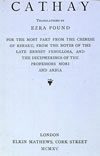
BK. Ezra Pound
 |
15. Cathay. London: Mathews, 1915.
A collection derived from Fenollosa’s notebooks that relies on Japanese materials only to the extent that the Chinese poems recreated in English by Pound had been filtered through Fenollosa, his teacher Mori Kainan (Ap), and his student and friend Ariga Nagao (Ap), who prepared for Fenollosa English versions of the poems that were the subject of Mori’s lectures. Though the collection sullied Pound’s reputation among Sinologists, its influence has been profound, as noted by Eliot in his often-quoted declaration that Pound is ‘the inventor of Chinese poetry for our time’ (Introduction to Pound’s Selected Poems [39], p. 14), and by Fletcher in the contention that publication of the collection was the central moment in the development of the ‘new poetry’ (see BH15). Before Cathay European-language translation of East Asian verse had been rhymed and tightly-metered, characterised by Herbert Giles in work from the Chinese and Dickins (D3), Mitford (D4), Aston (D13), Chamberlain (D5a), and Porter (D20) from the Japanese. After Cathay these translations seemed a failed attempt to fit vibrant traditions into small and decorative English containers, Li Po as balladeer, Bashô as epigrammatist. Hearn (see D9b) and Noguchi (see especially D15e6) must be credited with having tried to enlarge the container, but neither had Pound’s skill. The undecorated free verse of Cathay made it impossible for later writers to think of the East Asian literary tradition in the ways that had pertained before. The work is reprinted in 37, 39, and 60, and selections appear in 58 and 74. See also A7, BA7, BH2b, 25g, BK26, 86, 94, 98, 102, 109, 123, 133, and D10 and 20.

